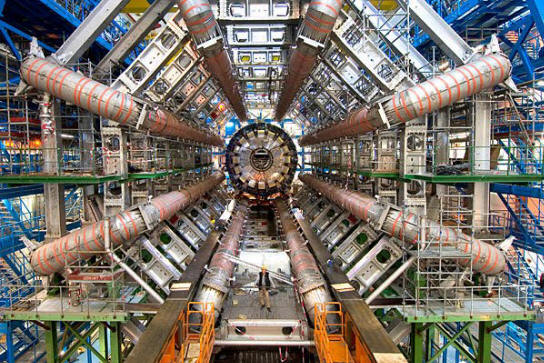The idea of a Large Hadron
Collider (LHC) was originally
proposed early in the 1980s. Since
the Large Electron Positron Collider
(LEP) was at the end of its life,
and a machine capable of generating
more power was needed, a 20 nation
consortium, all members of CERN (Conseil
Europeen pour la Recherche Nucleaire),
started design work in 1994.
The LHC straddles the border
between Switzerland and France,
occupying a 27 kilometer long,
circular tunnel. Its electromagnets
force protons into a narrow beam,
split it in two, and then send the
two streams of charged particles
around the ring in opposite
directions, causing the twin beams
to collide head on.
Although the LHC was built to
carry out a number of experiments,
most particle physicists will admit
that the $10 billion was spent to
find the Higgs boson.
Physicists postulate that matter
is built from twelve fundamental
particles, six quarks and six
leptons. Note that protons and
neutrons are not considered
"fundamental," since they are made
of quarks. Quarks are defined as
elementary particles with electric
charges one-third or two-thirds that
of the electron. Leptons are a group
of elementary particles (and
antiparticles), such as electrons,
muons, or neutrinos that are
affected by electromagnetic and weak
interactions.
According to the standard theory
of quantum mechanics, quarks are "colored"
and "flavored," but a detailed
explanation of those fields of
influence is not germane to this
account. The quark flavors are up,
down, bottom, top, strange, and
charm. Each of the six quark flavors
can have three different colors,
red, green, or blue. The lepton
table includes the electron,
electron-neutrino, muon, muon-neutrino,
tau, and tau-neutrino. The muon and
the tau leptons are not stable,
however, and quickly decay.
While leptons are thought to
participate in weak atomic
interactions, other particles such
as mesons, baryons, and hadrons are
more massive and are affected by
strong force influences. Quantum
mechanics proposes that there are
four forces at work in nature: the
strong force, which holds atomic
nuclei together; the electromagnetic
force, which holds atoms and
molecules together; the weak force,
which governs radioactive decay; and
the gravitational force, which
attracts matter to itself in an
inverse square relationship over
infinite distance.
According to nuclear physicists,
a "force" is more like an exchange.
When the strong force binds an
atomic nucleus together, for
example, the particles exchange
"carrier particles," called
bosons. Each force
requires its own boson. It is the
photon that supposedly
carries the electromagnetic force,
and "gluons"
carry the strong force. An ongoing
problem for physicists is the
detection of "gravitons" that
supposedly carry the gravitational
force.
In 1964, Peter Higgs speculated
that space is permeated by a
"field," similar to an
electromagnetic field. When
particles travel through space, they
encounter this field, acquiring
"mass." The concept can be
illustrated by particles moving
through a viscous fluid: the greater
interaction of particles with the
field, the greater their mass. The
existence of the Higgs field is an
essential component of his
hypothesis.
As previously mentioned, quantum
theory requires that fields be
associated with carrier particles,
so the expectation is that there
must be a particle carrying the
Higgs field: the Higgs boson. For
the last few years, LHC's focus has
been to "find" the Higgs boson and
determine if this mass origin
hypothesis is correct.
Recently,
physicists announced that
LHC had shown hints that the
Higgs-Boson was "real." However,
experiments in the 145 billion to
466 billion electron volt range have
excluded the boson's
existence. As Dmitri Denisov of
Fermilab said: "We do not
see the signal. If it existed, we
would see it. But when we look at
our data, we basically see nothing."
Electric Universe advocates
propose that the entire quantum
mechanical universe requires a new
viewpoint. Since it is the
electric force that
governs the cosmos, the behavior,
origin, and structure of matter
needs to be revised. One of the most
interesting aspects of this premise
is the clues that exist within
quantum mechanics, itself.
Plasma's electrical and physical
properties are scalable over many
orders of magnitude. Laboratory
experiments can model what is
observed in space. Gravity's force
falls off with the square of the
distance, while the attraction
between electrified plasma filaments
is linear and up to 39 orders of
magnitude greater than gravity.
Looking at the four hypothetical
quantum forces, it can be seen that
the strong force is also 39 orders
of magnitude greater than gravity.
Perhaps that relationship is better
explained with the electric force.
Virtual models operating within
computer algorithms have replaced
direct observation in recent years:
the natural philosophy of science
has been abandoned. Computer models
are used to build other models,
which, in turn, are used to
"confirm" further models. Physics
used to mean investigating the
nature and properties of matter and
energy. Instead, it has become the
handmaiden to mathematics.
Stephen Smith
 New
DVD
New
DVD
The Lightning-Scarred
Planet Mars
A video documentary that could
change everything you thought you
knew about ancient times and
symbols. In this second episode of
Symbols of an Alien Sky, David
Talbott takes the viewer on an
odyssey across the surface of Mars.
Exploring feature after feature of
the planet, he finds that only
electric arcs could produce the
observed patterns. The high
resolution images reveal massive
channels and gouges, great mounds,
and crater chains, none finding an
explanation in traditional geology,
but all matching the scars from
electric discharge experiments in
the laboratory. (Approximately 85
minutes)
Video Selections
Order Link





 New
DVD
New
DVD

